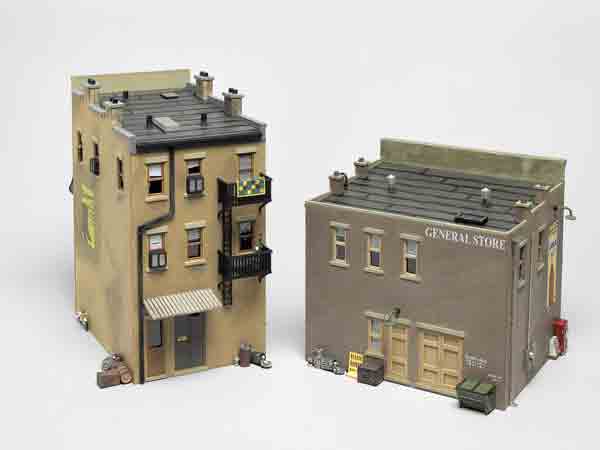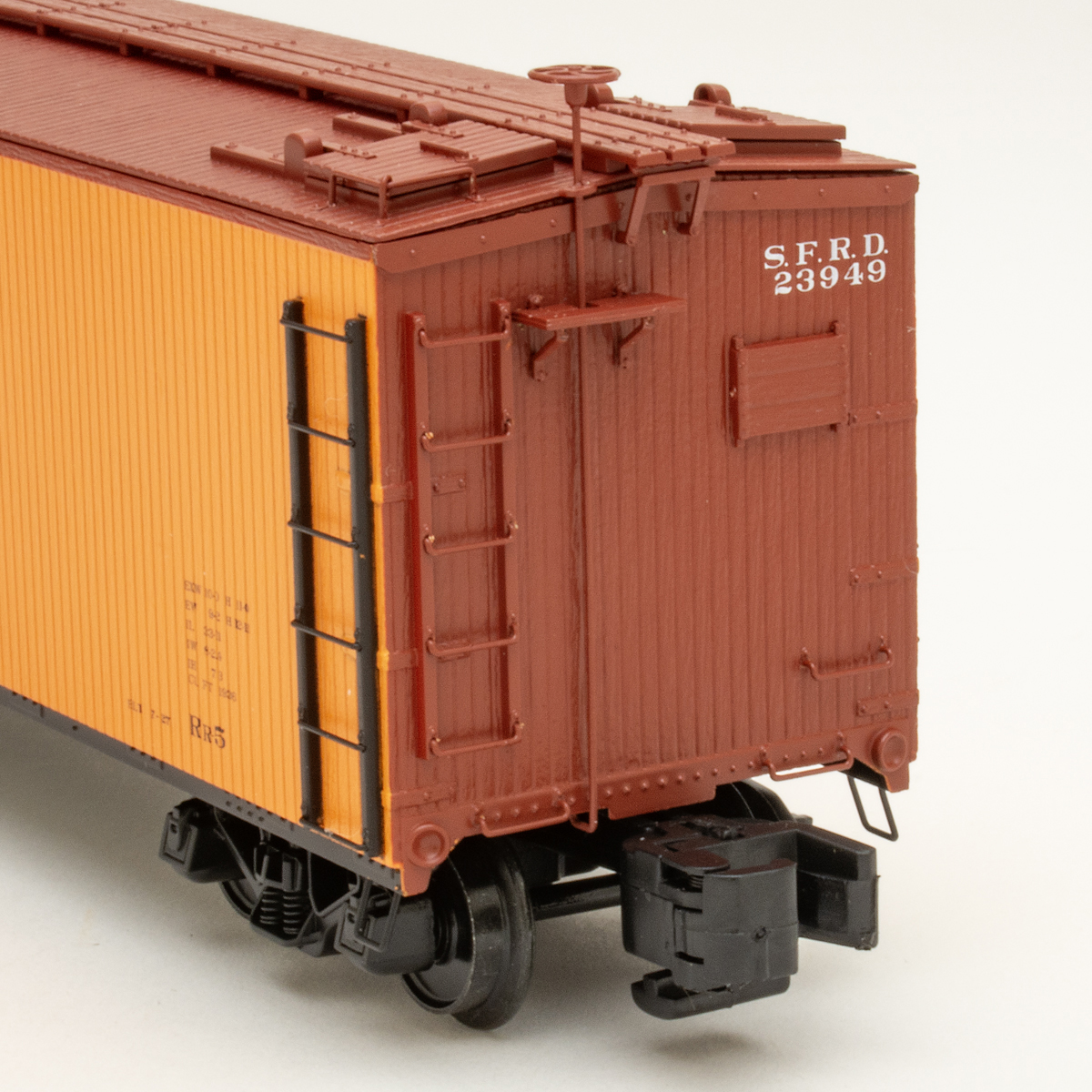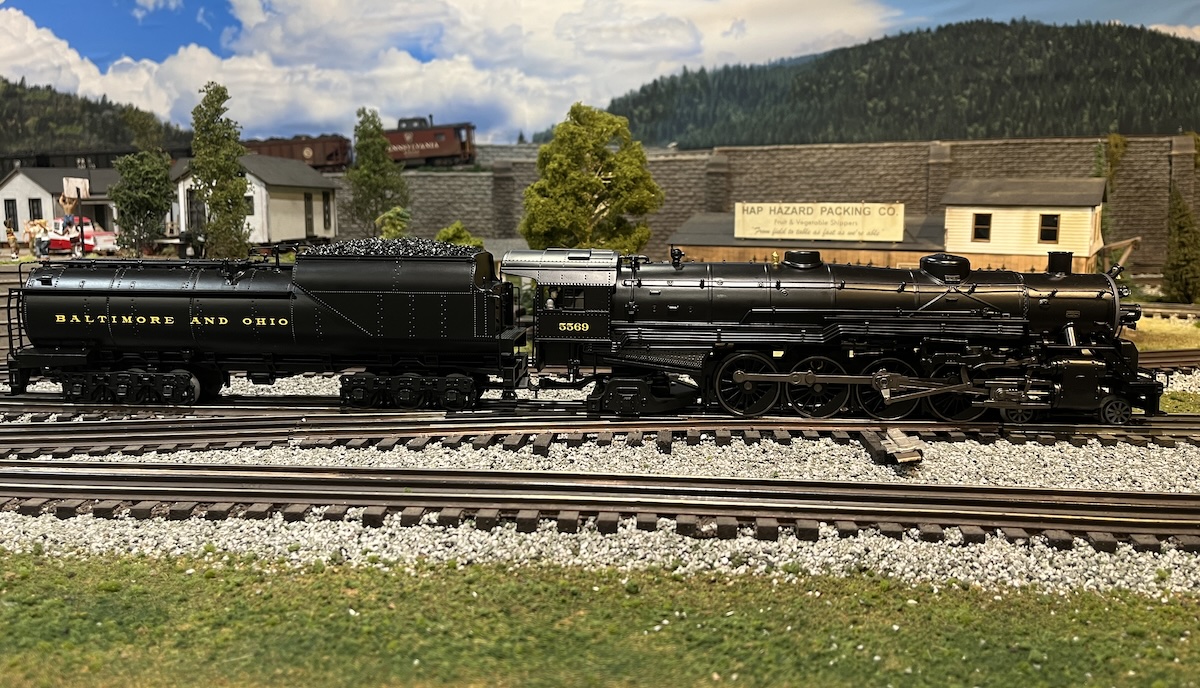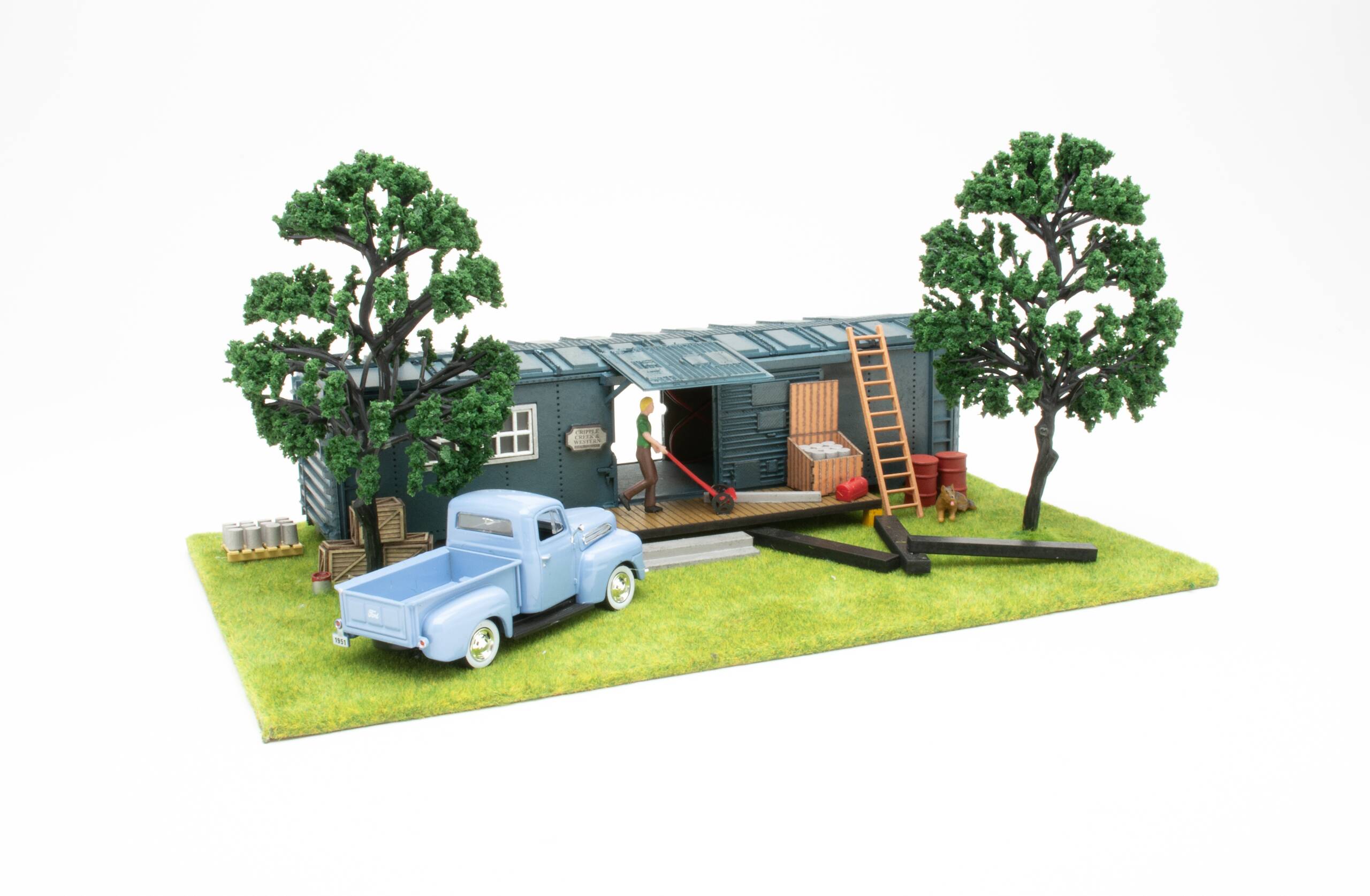Nope. It’s not that. The answer is actually quite simple.
Here is a smart new product for the O scale market that will spruce up the appearance of a layout just by opening the box and placing it trackside.
True confessions
The only time in recent years that I’ve been jealous of the HO and N scale worlds was when Woodland Scenics offered assembled and detailed structures under the “Built-&-Ready” name. The structures are fully assembled, painted, and detailed to an amazing degree. This is indeed a step or two beyond the level of detail that has been available in more recent times.
While there are many happy hobbyists mixing everything from Plasticville and K-Line to MTH structures, many operators gravitated to a more homogenized look with more realistic edifices. But even as spoiled as I’ve become with ready-to-place buildings, I want more. There tends to be a certain neatness and uniformity that needs tweaking.
Detailing and weathering represent the final frontier for me. I don’t mind messing around in this area, but I’m more interested in running a railroad than replicating a city. Most out-of-the-box structures are, let me say, like a turkey sandwich – nice and tasty and filling. As you’ll note, however, the Woodland Scenics structures are the whole Thanksgiving dinner, minus that weird gelatin dish nobody likes!
The first structures in this series could easily fit on a layout with a farm town, a medium-size city, or even a segment of a larger place like Chicago or Boston. The initial run consists of three structures. These are the nos. BR5841 two-story Lubener’s General Store and the BR5843 J. W. Cobbler three-story shoe shop, and the BR5842 Harrison’s Hardware store.
Lubener’s General Store
I’m old enough to recall the days of corner neighborhood stores. I’m not talking about something like a 7-11, but businesses where you could get the staples, maybe some fresh fruits and vegetables, and most importantly from a kid’s point of view, 10-cent comic books.
Lubener’s store evokes these memories with a name that sounds vaguely similar to Lum & Abner’s Jot’em Down Store. Starting from the top down, the roof looks great. It has a rough black wash over a brown surface, with darker lines suggesting roof tar. There are four chimneys, two exhausts, and a roof access hatch. There is also a ladder going over the right side of the roof.
The sides of the building are brown brick, with a lighter shade between bricks to simulate mortar. There is textured trim along the roof to suggest carved stone or shaped concrete.
As the photos illustrate, a lot of detailing has been added to the sides. All the windows have interior treatments, each of which seems to be in a slightly different position. One first floor window clearly has been boarded up (maybe due to a burglary).
The right side of the structure has an old refrigerator (with a top-mounted motor) lettered “Ice.” A weather-worn advertisement for the Boston Garter Co. is mounted high on the wall. A silver rain spout runs from the roof to the ground, as does the access ladder.
The rear of the store has several add-on pieces, including three trash cans chock-full of garbage, a hand truck, and a crate. At ground level there are two cast-in doors (a single door and a double door for deliveries). A non-functional gooseneck light hangs above the single doorway.
The left side features another rain spout and an electrical hookup with the a round electric meter on a cabinet. There is a red soda machine with no visible branding, but if you lived through the era, you know only one brand used a machine looking like this one (it reminds me of a Vendo Model 39).
There is also a partially filled rack full of empties to the machine’s left. Am I the only one left who thinks returnable and reusable glass bottles were a great idea? Boy, these structures bring back memories of how life was not all that long ago.
High above the machine is a generic soda pop ad and another gooseneck security light.
The front, of course, is the main selling point for the structure. Just above the General Store sign are three green gooseneck lamps. Green awnings are above the two main show windows as well as what I guess is the entry for dwellers of the above-store apartments. They have a gentle sway (or sag) that nicely gives the look of a canvas or cloth awning, not a metal shield.
An array of farm-fresh fruits and veggies are in crates stacked upon barrels. There also are a cut watermelon, some large sacks, and one open sack containing what appear to be onions.
On the right side is a bench with a small stack of newspapers and one spread wide.
The front door is recessed, and there is a twin dispenser gumball machine to the left and another barrel to the right. The left window announces a sale of tomatoes and bananas, while the right window touts fresh fish. The door has an open sign and graphics for window blinds with pull cords.
In the back is a full-color rendering of the interior of a small store. But the coolest thing was what I saw peering inside to look at the backdrop. The cardstock backdrop is also a cardstock floor, and it has an old-time country store wooden plank floor look to it. Neat. The only thing missing is an image of a revolving comic book rack!
There is no interior lighting (an easy fix), and three of the four sides have a black sheath on the inside.
J.W. Cobbler shoe shop
Keep in mind that even though I can see the outline of the sign (a tall black boot), the name J.W. Cobbler suggests an eatery. But that may be the fact this is being written near Thanksgiving, and I have gobblers on the mind.
Though the construction of this three-story model is basically the same as the two-story Lubener’s, our sample was finished in a lighter shade of brown with occasional reddish brown bricks.
The roof was similar in decoration, a black wash over a vaguely gray base. The roof has four chimneys, three vents, and two square objects that could be exhausts or hatches.
The right side has the basic light tan color, but with some blotches to suggest weather wear or perhaps old signage that has been painted over.
About four inches up is an ad for Bruckman’s hand-crafted boots. There are three apartment windows, all with individually designed Venetian blinds.
One has a flower pot on the window ledge, while another houses an air conditioner. Below, you’ll find a girl’s bicycle and an assortment of trash cans, crates, and barrels affixed to the wall.
The back of the building has six apartment windows, each with Venetian blinds in different positions. There is a rain gutter on the roof that feeds into an angled spout system to the ground. This rain spout is totally different from that on the general store. There are two window-mounted air conditioners.
The right two windows have fire escape decks joined by a ladder. One has a multi-colored quilt draped over the railing, while the other has a large potted plant on the floor grate.
Directly below are more of the ubiquitous turned over trash cans. Let me note that these are unique cans/trash, not just the same old cans used in two different places.
On the rear of the ground floor are two door sets, a single doorway marked “private entrance” and a double-door marked “deliveries only.”
On the left side is an electrical junction box differing slightly from the one mounted on the general store.
There is also a dumpster, with a kitty on top, ready to pounce on any O scale mice it spies.
You have staining similar to that on the opposite side. This application suggests portions of the wall might have been painted over to make way for the “Laundry services” sign mounted there.
There are two apartment windows, one sporting a flower box and the other an air conditioner.
The front is, of course, the crowning jewel. On the left side there are cupola windows, presumably for each living room of the upstairs apartments. The curtains are generally unique.
You can almost envision Sam Spade from The Maltese Falcon standing behind them, looking down on the street to see Kasper Gutman’s minion, Wilmer Cook, lurking in the shadows awaiting Captain Jacoby’s arrival.
The two single windows on the right each have safety rails on the lower pane.
Above the front entry is a single green awning. You get the sense that it’s made of cloth because the “fabric” seems to sag between the end bars and the center bar.
The storefront is nicely accented in green, tan, and a crème color. The left window has signage for soles, heels, purses, leather garments, and shoe dyeing. Behind the window is a large trunk with red and brown boots on display for all to see.
The other window has nice graphics for J.W. Cobbler, and on display are two pairs of boots and a pair of ice skates. One woman is standing to the left of the front door, and another is parked on a bench in front.
The cardstock insert has graphics for a shoe shop (shoes on display, a counter, and a cash register) and the same wood plank flooring applied in the general store.
Pluses and few minuses
Sure, Woodland Scenics has offered these structures in HO and N scale, but just because you have the blueprints doesn’t mean you can just enlarge them a bit and create a successful product line. So my hat is unashamedly off to them for taking this step.
The plastic construction is first-rate, and the simple decoration itself – the intricate multiple colors of the front cupolas, for instance, with brown trim, green accents, and yellow-gold window frames are great.
I know I would not have been able to accomplish anything nearly as neatly executed with my shaky hand and a narrow paintbrush.
The selection of add-on items is an interesting and economical way to make each structure unique.
Oh, the first three buildings of the line are different structures, but any of them could be re-released in the future as bookshops, delis, dress shops, or men’s stores with the placement of varied detail items like flower pots, fire escapes, air conditioners, and electric meter boxes making a tableau as varied as a drive through any downtown section in America.
I don’t know if this would be a plus or a minus, but there is no foundation on any of the buildings.
The good side is that this lets you create your own foundation and street level. On the other hand, if you use MTH or another brand of structures with a sidewalk base or other plastic platform, the sidewalks and building levels will be uneven.
As mentioned, there is no interior lighting, but this can be remedied easily enough with a low-voltage bulb.
So three cheers for Woodland Scenics for entering this niche of the scenery market in spite of global gloom and doom. These structures are quality products, and Woodland Scenics has hit a home run with them.
Features: Fully assembled, painted, weathered, with add-on detail pieces















I have many of their kits which I enjoy detailing and Painting. HO size Kits.
The only pre finished 1 I bought was the motorcycle Shop at a very reasonable cost a few years ago compared to the current prices.
A large investment of the last 25 years . Prices now are very high compared to a few years ago so happy I purchased back then.
Love these buildings! But like other comments, they are out of my price range. Yes the hobby is expensive, but like anything else, where there is no competition for a product ( and you can't go anywhere else to get one like it) the manufacturer will get whatever it can. Whoever can come up with similar quality buildings at a reasonable price will not be able to keep up with demand. Any real innovators out there?
I purchased the Menard building for 70.00 at the local Menard's. It is a great looking building. I added a light to the building and agree with John that the extra detailing makes the buildings worth the investment (but not at the $100 plus suggested retail. I appreciate the fact that the hobby is expensive, but some of us have limited budgets.
I have all 3 of these buildings, after XMAS sales. $70.00 each At that price it's not such a bad deal, considering all the detail. The detail parts are $20 to $25 dollars per building or more. Now with that said they really aren't as expensive as adding all that detail to an MTH or Lionel building. It was a dream come true for me, I always drooled over WS's N & HO building. Now
I have it in 0 gauge, thanks WS !!!!!!!!!!
These are nice and detailed but out of the average modelers price range, 60.00 for an MTH structure is crazy as it is but over a hundred for 1 yikes! I canbuy one a year and have all them in three years as long as they don't release anymore. This hobby is expensive so we have to pay the price.
I also purchased the Menard's building and am glad to have a
building of this detail on my layout. Looking forward to adding more
of the WS structures as they become available. I have built the entire
line of prefab structures in HO. Woodland Scenics should consider
producing the O scale buildings in kit form to reduce the cost. They would be an instant hit with O scalers.
I totally agree with Bob's assement. I purchased the Menard's building for $79 and after Christmas for $69. I added poster board bases and lights. Woodland Senic put and outstanding product on the Market for O gaugers.
Prices will hamper the hobby, but after seeing the detail I could not resist. I was in shock when the (train expense hater) (wife) agreed to the purchase.
Agree with Tom's assessment. Too bad these can't be made for a more reasonable price. Everything in todays world is way too expensive.for a model railroader.
The only drawback to these buildings is that they will make the lack of detail on other buildings stand out. These are clearly forground structures! A great job by a great manufacturer